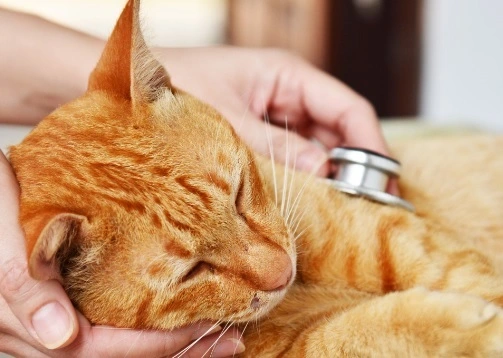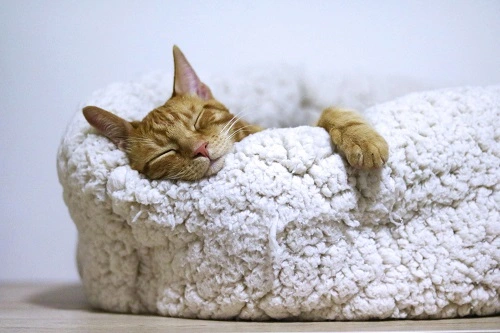As a cat owner, learning your beloved pet has been diagnosed with feline leukemia can be devastating. Feline leukemia is a retrovirus that suppresses the immune system, leaving cats susceptible to an array of secondary infections and cancers.
Dealing a cat with feline leukemia can be difficult. This article explores when to euthanize a cat with feline leukemia and how to support your cat through the process.
It can impact the blood, bone marrow, intestines and more. While some cats may only exhibit mild symptoms, in other cases the disease can be fatal within years or even months of contraction.
When to Euthanize a Cat with Feline Leukemia
When a cat’s quality of life declines significantly due to advancing feline leukemia, euthanasia may be the most humane option. Determining the right time to let go is extremely difficult emotionally, but avoiding prolonged suffering is an act of love.
In this article, I will compassionately guide you through what to look for when assessing your cat’s condition and deciding when euthanasia may be appropriate. I will also share how to ease your cat’s transition when the time comes. My goal is to help you make the best decision for your beloved feline family member in feline leukemia.
Evaluating When Quality of Life Has Diminished
Feline leukemia progresses differently in individual cats, so there is no definitive timeline or checklist for when to euthanize. The decision depends on your veterinarian’s prognosis and your own observances of your cat’s wellbeing declining. There are some key signs of feline leukemia that has advanced too far:
Significant Pain and Discomfort
- Chronic pain from cancer, infections, dental disease or other conditions that cannot be adequately controlled with medication.
- Labored breathing, indicating fluid accumulation in lungs or chest tumors.
- Lethargy, inability to stand or loss of appetite from advanced anemia.
- Severe nausea, vomiting or diarrhea that causes dehydration.
Compromised Immune System
- Recurring infections not responding to treatment.
- Open sores, bleeding or blood clotting issues.
- Enlarged lymph nodes or spleen.
- Pale gums, ear tips and paw pads from anemia.
Deteriorating Quality of Life
- Marked weight loss and muscle wasting despite nutritional support.
- Minimal interest in surroundings, interactions or formerly enjoyed activities.
- No longer grooming self, resulting in matted, urine-soaked fur.
- Hiding more, disconnected from the family.
- Struggling with litter box habits.

As a devoted cat parent, take time to objectively assess if your pet is still able to experience basic comforts and joys day-to-day or is plagued by sustained suffering. Your veterinarian can guide you about prognosis and options. Euthanasia may be kindest once little can be done to restore reasonable quality of life.
Preparing for the Euthanasia Process
Once the excruciating decision is made to euthanize your cat, thoughtfully preparing can provide some comfort in an agonizing time. Here are suggestions for easing the process of When to Euthanize a Cat With Feline Leukemia:
Choose an At-Home or Clinic Setting
Most veterinarians can perform euthanasia at their clinic or your home. Consider your cat’s temperament and what will be least frightening. Home euthanasia allows your cat to pass in a familiar environment, but you then associate that space with the loss.
Decide if You Want to Be Present
Being with your beloved cat in their final moments can provide closure, but it is traumatic. Do what feels right for you and your family.
Coordinate Care for Other Pets
Make arrangements for someone to care for your other pets during and after the euthanasia process. Keep them comfortable and unaware.

Prepare Comfort Items
Have your cat’s favorite toys, treats, bed and your affection readily available. Play calming music and use calming scents like lavender. Make the environment as soothing as possible. It helps in understanding When to Euthanize a Cat With Feline Leukemia.
Choose After Care
Decide if you want a private cremation for your cat’s ashes to be returned or a communal pet cremation. Alternatively, you can opt for burial if space allows. This will influence options like paw print impressions.
While emotionally devastating, intentionally preparing for euthanasia can lessen regrets. Take things step by step while lavishing your beloved cat with love.
Ensuring Your Cat’s Comfort Until the End
The time leading up to euthanasia is intensely painful. Yet this makes your dedication to ensuring your cat’s comfort and calming their fears in their remaining days all the more vital:
- Keep to comforting routines but avoid high-exertion playtime.
- Help them rest in preferred sleeping spots and provide warm, soft bedding.
- Tempt their appetite with favorite treats or foods. Consider appetite stimulants.
- Attend grooming needs like nail trims, dental care or gentle brushing.
- Respond promptly to litter box accidents with cleaning and fresh bedding.
- Continue prescribed medications and monitor for new symptoms.
- Shower them with affection and quality time together.
- Indulge safe adventures like time outdoors, car rides or new sights/sounds.
While nothing can stop the inevitable, attentively catering to your cat’s needs provides solace during the anguish of letting go.
Saying Goodbye on Their Final Day
The day the euthanasia is scheduled will be gut wrenching. As you brace for farewell, a few final acts of love can memorialize your bond:
- Capture paw prints and gather tufts of fur for keepsakes, if desired.
- Brush and pamper your cat to look their best. Offer favorite foods.
- Cuddle and reminisce on joyful memories together. Reassure your pet of your eternal love.
- Allow other family members private goodbyes if desired.
- Transport your cat in a comfortable carrier along with cherished toys or blankets.
- Remain calm at the veterinary clinic. Anxiety is contagious.
- Stay with your cat during the process if you chose, offering soothing touches and words.
- Extend sincere thanks to the veterinary team for their compassionate care.
While the grief will be immense, taking these meaningful steps helps provide closure on When to Euthanize a Cat With Feline Leukemia.
Coping With the Loss of a Beloved Feline Friend
Losing your cat is devastating, especially when cut short by illness. Be gentle with yourself as you mourn:
- Allow yourself to fully grieve. Do not suppress emotions.
- Consider joining a pet loss support group to process feelings.
- Memorialize your cat through a special object like a photo frame, plant or donation in their name.
- Postpone any big life changes immediately after the loss when emotions are raw.
- Comfort surviving pets who may also mourn the absence.
- Appreciate that your cat rests in peace, free of suffering because of your selfless act. Their spirit always surrounds you with love.
With time, the pain gives way to cherished memories of the pawprint your beloved companion left on your heart. Honor their memory and your bond. You gave the ultimate gift of relief from suffering – that is the greatest act of love.

